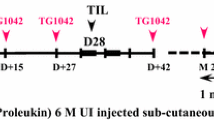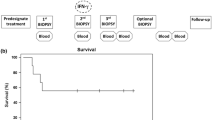Abstract
Background
An oncolytic herpes simplex virus engineered to replicate selectively in tumor cells and to express granulocyte–macrophage colony-stimulating factor (GM-CSF) was tested as a direct intralesional vaccination in melanoma patients. The work reported herein was performed to better characterize the effect of vaccination on local and distant antitumor immunity.
Methods
Metastatic melanoma patients with accessible lesions were enrolled in a multicenter 50-patient phase II clinical trial of an oncolytic herpesvirus encoding GM-CSF (OncovexGM-CSF). An initial priming dose of 106 pfu vaccine was given by intratumoral injection, followed by 108 pfu every 2 weeks to 24 total doses. Peripheral blood and tumor tissue were collected for analysis of effector T cells, CD4+FoxP3+ regulatory T cells (Treg), CD8+FoxP3+ suppressor T cells (Ts), and myeloid-derived suppressive cells (MDSC).
Results
Phenotypic analysis of T cells derived from tumor samples suggested distinct differences from peripheral blood T cells. There was an increase in melanoma-associated antigen recognized by T cells (MART-1)-specific T cells in tumors undergoing regression after vaccination compared with T cells derived from melanoma patients not treated with vaccine. There was also a significant decrease in Treg and Ts cells in injected lesions compared with noninjected lesions in the same and different melanoma patients. Similarly MDSC were increased in melanoma lesions but underwent a significant decrease only in vaccinated lesions.
Conclusions
Melanoma patients present with elevated levels of Tregs, Ts, and MDSC within established tumors. Direct injection of OncovexGM-CSF induces local and systemic antigen-specific T cell responses and decreases Treg, Ts, and MDSC in patients exhibiting therapeutic responses.








Similar content being viewed by others
References
Liu BL, Robinson M, Han ZQ, et al. ICP34.5 deleted herpes simplex virus with enhanced oncolytic, immune stimulating, and anti-tumour properties. Gene Ther. 2003;10(4):292–303.
Toda M, Martuza RL, Rabkin SD. Tumor growth inhibition by intratumoral inoculation of defective herpes simplex virus vectors expressing granulocyte-macrophage colony-stimulating factor. Mol Ther. 2000;2(4):324–9.
Hu JCC, Coffin RS, Davis CJ, et al. A Phase I study of OncoVEXGM-CSF, a second-generation oncolytic herpes simplex virus expressing granulocyte macrophage colony-stimulating factor. Clin Cancer Res. 2006;12(22):6737–47.
Senzer NN, Kaufman HL, Amatruda T, et al. Phase II clinical trial with a second generation, GM-CSF encoding, oncolytic herpesvirus in unresectable metastatic melanoma. J Clin Oncol. 2008;26:(May 20 suppl; abstr 9008).
Curiel TJ, Coukos G, Zou L, et al. Specific recruitment of regulatory T cells in ovarian carcinoma fosters immune privilege and predicts reduced survival. Nat Med. 2004;10(9):942–9.
Liyanage UK, Moore TT, Joo HG, et al. Prevalence of regulatory T cells is increased in peripheral blood and tumor microenvironment of patients with pancreas or breast adenocarcinoma. J Immunol. 2002;169(5):2756–61.
Whiteside TL. The role of immune cells in the tumor microenvironment. Cancer Treat Res. 2006;130:103–24.
Conejo-Garcia JR, Benencia F, Courreges M-C, et al. Tumor-infiltrating dendritic cell precursors recruited by a [beta]-defensin contribute to vasculogenesis under the influence of Vegf-A. Nat Med. 2004;10(9):950–8.
Battaglia A, Buzzonetti A, Baranello C, et al. Metastatic tumour cells favour the generation of a tolerogenic milieu in tumour draining lymph node in patients with early cervical cancer. Cancer Immunol Immunother. 2009;58(9):1363–73.
Zhang L, Conejo-Garcia JR, Katsaros D, et al. Intratumoral T cells, recurrence, and survival in epithelial ovarian cancer. N Engl J Med. 2003;348(3):203–13.
Kaufman HL, DeRaffele G, Mitcham J, et al. Targeting the local tumor microenvironment with vaccinia virus expressing B7.1 for the treatment of melanoma. J Clin Invest. 2005;115(7):1903–12.
Naito Y, Saito K, Shiiba K, et al. CD8+ T cells infiltrated within cancer cell nests as a prognostic factor in human colorectal cancer. Cancer Res. 1998;58(16):3491–4.
Nakano O, Sato M, Naito Y, et al. Proliferative activity of intratumoral CD8+ T-lymphocytes as a prognostic factor in human renal cell carcinoma: clinicopathologic demonstration of antitumor immunity. Cancer Res. 2001;61(13):5132–6.
Chang CC, Ciubotariu R, Manavalan JS, et al. Tolerization of dendritic cells by T(S) cells: the crucial role of inhibitory receptors ILT3 and ILT4. Nat Immunol. 2002;3(3):237–43.
Najafian N, Chitnis T, Salama AD, et al. Regulatory functions of CD8+ CD28− T cells in an autoimmune disease model. J Clin Invest. 2003;112(7):1037–48.
Rifa’i M, Kawamoto Y, Nakashima I, Suzuki H. Essential roles of CD8+CD122+ regulatory T cells in the maintenance of T cell homeostasis. J Exp Med. 2004;200(9):1123–34.
Xystrakis E, Dejean AS, Bernard I, et al. Identification of a novel natural regulatory CD8 T-cell subset and analysis of its mechanism of regulation. Blood. 2004;104(10):3294–301.
Cosmi L, Liotta F, Lazzeri E, et al. Human CD8+CD25+ thymocytes share phenotypic and functional features with CD4+CD25+ regulatory thymocytes. Blood. 2003;102(12):4107–14.
Liu Z, Tugulea S, Cortesini R, Suciu-Foca N. Specific suppression of T helper alloreactivity by allo-MHC class I-restricted CD8+CD28− T cells. Int Immunol. 1998;10(6):775–83.
Ciubotariu R, Colovai AI, Pennesi G, et al. Specific suppression of human CD4+ Th cell responses to pig MHC antigens by CD8+CD28− regulatory T cells. J Immunol. 1998;161(10):5193–202.
Colovai AI, Liu Z, Ciubotariu R, et al. Induction of xenoreactive CD4+ T-cell anergy by suppressor CD8+ CD28− T cells. Transplantation. 2000;69(7):1304–10.
Chaput N, Louafi S, Bardier A, et al. Identification of CD8+CD25+FoxP3+ suppressive T cells in colorectal cancer tissue. Gut. 2008:gut.2008.158824.
Kiniwa Y, Miyahara Y, Wang HY, et al. CD8+FoxP3+ regulatory T cells mediate immunosuppression in prostate cancer. Clin Cancer Res. 2007;13(23):6947–58.
Gabrilovich DI, Nagaraj S. Myeloid-derived suppressor cells as regulators of the immune system. Nat Rev Immunol. 2009;9(3):162–74 (advanced online publication).
Rodriguez PC, Zea AH, Culotta KS, et al. Regulation of T cell receptor CD3zeta chain expression by L-arginine. J Biol Chem. 2002;277(24):21123–9.
Zea AH, Rodriguez PC, Atkins MB, et al. Arginase-producing myeloid suppressor cells in renal cell carcinoma patients: a mechanism of tumor evasion. Cancer Res. 2005;65(8):3044–8.
Gabrilovich D, Ishida T, Oyama T, et al. Vascular endothelial growth factor inhibits the development of dendritic cells and dramatically affects the differentiation of multiple hematopoietic lineages in vivo. Blood. 1998;92(11):4150–66.
Cesana GC, DeRaffele G, Cohen S, et al. Characterization of CD4+CD25+ regulatory T cells in patients treated with high-dose interleukin-2 for metastatic melanoma or renal cell carcinoma. J Clin Oncol. 2006;24(7):1169–77.
Ahmadzadeh M, Rosenberg SA. IL-2 administration increases CD4+CD25(hi) FoxP3+ regulatory T cells in cancer patients. Blood. 2006;107(6):2409–14.
Jandus C, Bioley G, Speiser DE, Romero P. Selective accumulation of differentiated FOXP3(+) CD4 (+) T cells in metastatic tumor lesions from melanoma patients compared to peripheral blood. Cancer Immunol Immunother. 2008;57(12):1795–805.
Filaci G, Fenoglio D, Fravega M, et al. CD8+CD28 T regulatory lymphocytes inhibiting T cell proliferative and cytotoxic functions infiltrate human cancers. J Immunol. 2007;179(7):4323–34.
Maynard CL, Hatton RD, Helms WS, et al. Contrasting roles for all-trans retinoic acid in TGF-beta-mediated induction of FoxP3 and Il10 genes in developing regulatory T cells. J Exp Med. 2009;206(2):343–57.
Strome SE, Dong H, Tamura H, et al. B7-H1 blockade augments adoptive T-cell immunotherapy for squamous cell carcinoma. Cancer Res. 2003;63(19):6501–5.
Shibakita M, Tachibana M, Dhar DK, et al. Prognostic significance of Fas and Fas ligand expressions in human esophageal cancer. Clin Cancer Res. 1999;5(9):2464–9.
Ohm JE, Gabrilovich DI, Sempowski GD, et al. VEGF inhibits T-cell development and may contribute to tumor-induced immune suppression. Blood. 2003;101(12):4878–86.
Hori S, Nomura T, Sakaguchi S. Control of regulatory T cell development by the transcription factor FoxP3. Science. 2003;299(5609):1057–61.
Gavin MA, Rasmussen JP, Fontenot JD, et al. FoxP3-dependent programme of regulatory T-cell differentiation. Nature. 2007;445(7129):771–5.
Coombes JL, Siddiqui KR, Arancibia-Carcamo CV, et al. A functionally specialized population of mucosal CD103+DCs induces FoxP3+ regulatory T cells via a TGF-beta and retinoic acid-dependent mechanism. J Exp Med. 2007;204(8):1757–64.
Marigo I, Dolcetti L, Serafini P, et al. Tumor-induced tolerance and immune suppression by myeloid derived suppressor cells. Immunol Rev. 2008;222(1):162–79.
Kusmartsev S, Gabrilovich DI. Role of immature myeloid cells in mechanisms of immune evasion in cancer. Cancer Immunol Immunother. 2006;55(3):237–45.
Joetham A, Matsubara S, Okamoto M, et al. Plasticity of regulatory T cells: subversion of suppressive function and conversion to enhancement of lung allergic responses. J Immunol. 2008;180(11):7117–7124.
Qin H, Vlad G, Cortesini R, et al. CD8+ suppressor and cytotoxic T cells recognize the same human leukocyte antigen-A2 restricted cytomegalovirus peptide. Hum Immunol. 2008;69(11):776–80.
Financial Disclosure
Rob Coffin is employed by and has stock options in Biovex, Inc. the manufacturer of the vaccine used in this manuscript.
Author information
Authors and Affiliations
Corresponding author
Rights and permissions
About this article
Cite this article
Kaufman, H.L., Kim, D.W., DeRaffele, G. et al. Local and Distant Immunity Induced by Intralesional Vaccination with an Oncolytic Herpes Virus Encoding GM-CSF in Patients with Stage IIIc and IV Melanoma. Ann Surg Oncol 17, 718–730 (2010). https://doi.org/10.1245/s10434-009-0809-6
Received:
Published:
Issue Date:
DOI: https://doi.org/10.1245/s10434-009-0809-6




